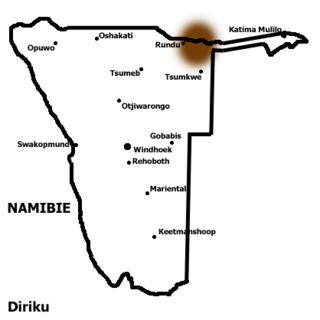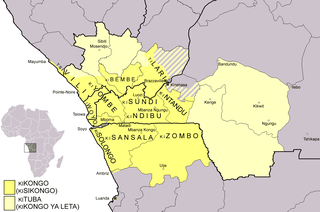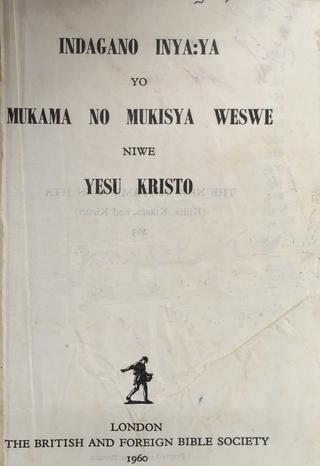Related Research Articles

The Bantu languages are a language family of about 600 languages that are spoken by the Bantu peoples of Central, Southern, Eastern and Southeast Africa. They form the largest branch of the Southern Bantoid languages.

Herero (Otjiherero) is a Bantu language spoken by the Herero and Mbanderu peoples in Namibia and Botswana, as well as by small communities of people in southwestern Angola. There were 250,000 speakers in these countries between 2015 and 2018.

Kimbundu, a Bantu language which has sometimes been called Mbundu or North Mbundu, is the second-most-widely-spoken Bantu language in Angola.

Portuguese is the only official language of Angola, but 46 other languages are spoken in the country, mostly Bantu languages.
Umbundu, or South Mbundu, one of many Bantu languages, is the most widely-spoken autochthonous language of Angola. Its speakers are known as Ovimbundu and are an ethnic group constituting a third of Angola's population. Their homeland is the Central Highlands of Angola and the coastal region west of these highlands, including the cities of Benguela and Lobito. Because of recent internal migration, there are now also large communities in the capital Luanda and its surrounding province, as well as in Lubango.

The 250 or so "Narrow Bantu languages" are conventionally divided up into geographic zones first proposed by Malcolm Guthrie (1967–1971). These were assigned letters A–S and divided into decades ; individual languages were assigned unit numbers, and dialects further subdivided. This coding system has become the standard for identifying Bantu languages; it was a practical way to distinguish many ambiguously named languages before the introduction of ISO 639-3 coding, and it continues to be widely used. Only Guthrie's Zone S is (sometimes) considered to be a genealogical group. Since Guthrie's time a Zone J has been set up as another possible genealogical group bordering the Great Lakes.
Mbukushu or Thimbukushu is a Bantu language spoken by 45,000 people along the Kavango East Region in Namibia, where it is a national language, and in Botswana, Angola and Zambia.
Kwangali, or RuKwangali, is a Bantu language spoken by 85,000 people along the Kavango River in Namibia, where it is a national language, and in Angola. It is one of several Bantu languages of the Kavango which have click consonants; these are the dental clicks c and gc, along with prenasalization and aspiration.

Gciriku, or Dciriku, is a Bantu language spoken by 305,000 people along the Kavango River in Namibia, Botswana and Angola. 24,000 people speak Gciriku in Angola, according to Ethnologue. It was first known in the west via the Vagciriku, who had migrated from the main Vamanyo area and spoke Rugciriku, a dialect of Rumanyo. The name Gciriku remains common in the literature, but within Namibia the name Rumanyo has been revived. The Mbogedu dialect is extinct; Maho (2009) lists it as a distinct language, and notes that the names 'Manyo' and 'Rumanyo' are inappropriate for it.

Ibinda is ostensibly a Bantu language or a dialect group spoken in the Angolan province and exclave of Cabinda.
Chokwe is a Bantu language spoken by the Chokwe people of the Democratic Republic of the Congo, Angola and Zambia. It is recognised as a national language of Angola, where half a million people were estimated to have spoken it in 1991; another half a million speakers lived in the Congo in 1990, and some 20,000 in Zambia in 2010. It is used as a lingua franca in eastern Angola.
The Kwisi are a seashore-fishing and hunter-gatherer people of southwest Angola that physically seem to be a remnant of an indigenous population—along with the Kwadi, the Cimba, and the Damara—that are unlike either the San (Bushmen) or the Bantu. Culturally they have been strongly influenced by the Kuvale, and speak the Kuvale dialect of Herero. There may, however, have been a few elderly speakers of an unattested Kwisi language in the 1960s.
The Kavango – Southwest Bantu languages are a group of Bantu languages established by Anita Pfouts (2003). The Southwest Bantu languages constitute most of Guthrie's Zone R. The languages, or clusters, along with their Guthrie identifications, are:

Jita is a Bantu language of Tanzania, spoken on the southeastern shore of Lake Victoria/Nyanza and on the island of Ukerewe.
Bolo, also known as Ngoya and Kibala, is a Bantu language of Angola that is closely related to Kimbundu.
Ndombe (Dombe) is a Bantu language of Angola. It was assigned by Guthrie to Bantu group R.10, which apart from Umbundu Pfouts (2003) established as part of the Kavango–Southwest branch of Bantu. Though not specifically addressed, Ndombe may be in that branch as well.
Sidi is a Bantu language of Pakistan and India, related to Swahili. Most of the Sidi community today speaks a regional Indic language, mostly Gujarati, mixed with some Bantu words and phrases, and the current number of speakers is unknown. It was reportedly still spoken in the 1960s in Jambur, a village in Kathiawar, Gujarat, by the Siddi. A survey of regional languages conducted by the government of Gujarat in 2016 reported that the language is in danger of extinction.
Mbali is a minor Bantu language of Angola, spoken on the coast on the southern edge of the large Umbundu-speaking area and the northern end of the uninhabited Namib desert. Its classification is unclear. Arends et al. suggest it might turn out to be a Kimbundu–Umbundu mixed language, though it is nowhere near Kimbundu territory.
Ngoya, also known as Pala, is a newly recognized language of Angola that since ca. 2010 has been used for national radio broadcasts. It had previously been considered a dialect of Kimbundu without any linguistic evidence, and appears to be transitional between Kimbundu and Umbundu.
Thilo Christian Schadeberg is an Emeritus Professor of Bantu Linguistics at the Centre for Linguistics of Leiden University.
References
- ↑ Kuvale language at Ethnologue (19th ed., 2016)

- 1 2 Jouni Filip Maho, 2009. New Updated Guthrie List Online